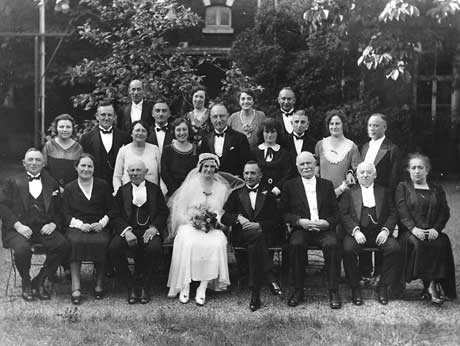Anmerkungen von Hans-Dieter Arntz
Wenn ehemalige jüdische Mitbürger oder deren Nachkommen wieder in ihre “alte Heimat” zurückkehren, dann gibt es häufig bewegende Momente. Derartige Besuche, die häufig als „Stippvisiten“ in mehrtägige Deutschlandreisen eingebaut werden, sind verschieden motiviert. Bei jüngeren Besuchern, die in 2. oder 3. Generation schon gar nicht mehr Deutsch sprechen, aber neuerdings sehr genealogisch orientiert sind, ist die Rückkehr zu den „roots“ sehr realistisch, sachlich und beinahe historisch bedingt.
Wer aber irgendwie noch seine Jugend in Deutschland bewusst erlebt hat, dessen Gefühle sind bei einer Rückkehr recht nostalgisch. In dieser Hinsicht ähneln sich grundsätzlich ältere Menschen, wenn sie das besuchen, was mit „ehemaliger Heimat“ bezeichnet wird. Elternhaus, Schulgebäude, Freunde oder Fotos verstärken die Dimension der Erinnerung. Als Begleiter jüdischer Besucher bekommt man jedoch hiervon nur einen kleinen Eindruck.
Von regionalhistorischem Interesse sind später die meist sehr persönlich gehaltenen Berichte über eine solche „Stippvisite“, weil sie als indirekte Perspektive das widerspiegeln, was den einstigen Flüchtlingen tatsächlich wesentlich erschien. Die Eindrücke des aus Euskirchen stammenden Ignatz Hanauer (1885-1971), der im Jahre 1966 – 60 Jahre nach seiner „normalen“ Auswanderung in die USA – wieder seine alte Heimat besuchte, stellen sicherlich einen Unterschied zu denen von Ruth Ruth Breshinski (geb.1933) aus Tel Aviv dar, die im Herbst 2008 wieder vor ihrem Elternhaus stand.
Unter der Überschrift „Arisierungen“ jüdischer Geschäfte werden bei heutigen Firmenjubiläen oft vergessen behandelte ich im Frühjahr 2008 das Schicksal der jüdischen Familie Fromm aus Euskirchen, zu der seitdem wieder ein persönlicher Kontakt besteht. In der bekannten jüdischen Zeitung Jewish Standard (New Jersey/USA) vom 26. Dezember 2008 berichtet der aus Euskirchen stammende Egon Fromm (geb. 1931) über seine erneute Begegnung mit der deutschen Vergangenheit. Die sehr ausführliche Cover Story der „Jewish Standard“ behandelt seine Teilnahme an einer Gedenkfeier in Hellenthal und ist auch ein regionalhistorischer Beitrag zum Judentum in der Eifel und Voreifel.
LINKS
| Egon and Joan Fromm: “Uncovering our roots” |
|
| Wikipedia: The Jewish Standard (New Jersey/USA) |
Ein jüdischer Flüchtling aus Euskirchen/Hellenthal
begegnet der deutschen Geschichte
|
The wedding of Walter and Carola Heuman Fromm on Aug. 24, 1930, in Euskirchen, Germany. Members of both families attended. Courtesy Egon fromm |
It started as a summer vacation in 1973, a roots trip for us to the town of Hellenthal, Germany, the home of Carola Heuman Fromm, her parents, grandparents, brothers, and sisters; to Dueren, the birthplace of Walter Fromm and his parents and brothers; to Euskirchen, Egon’s birthplace and home, where he lived with his parents and sister until they left Germany in October 1938 to arrive in the United States on Nov. 4, 1938 — luckily and with the help of God, five days before Kristallnacht. They had been encouraged to emigrate, and were sponsored, by Uncle Karl (Walter’s brother), an engineer who left Germany in 1927 and was employed by Worthington Pump Co. in Harrison, N.J. Unfortunately, the family did not get to know him well, as he died within weeks of their arrival.
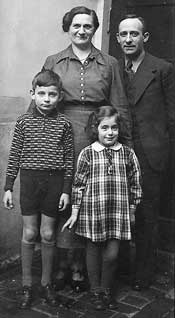 |
Carola and Walter Fromm are pictured with their children, Doris and Egon, |
It started in Dueren. There were not so many memories of time spent there. Nevertheless, as we drove through the town, it seemed as though someone else was steering the car as we found Walter’s house and came to a stop there. It seemed almost mystical. Where there had been a row of homes, these were now interrupted by stores, although we did locate Walter’s house and were able to go inside it.
We then moved on to Euskirchen. (All of these towns are west of the Rhine, between Cologne and the Belgian border.) There was Baumstrasse 7, home of the Fromm family. The big backyard of memory had become much smaller because of neighborhood growth and development, but the town’s church spire with the chiming clock was still there and visible from the back of the house. It was on this clock that kleiner Egon learned to tell time from the view through his bedroom window.
We strolled through the town, much of it the same as in Egon’s youth. There was the town square where he remembered watching the parade after the Austrian Anschluss in the spring of 1938, including, at the end of the parade, the Hitler Jugend, as he, the Jewish kid, watched his classmates, with some jealousy, marching in their neat white shirts, black shorts, and armbands, singing as they carried the Nazi flag. He didn’t really understand why he could not participate, though he knew that, as a Jew, he could not.
Euskirchen was small by our standards, the buildings small and close together. There are the metzgerei (butcher), baeckerei (bakery), and other stores. We walked and came to a small space with two steps leading from the sidewalk to a grassy area. There, in the middle of the town, Egon said, “You’re now standing in what was my synagogue!” (This was completely destroyed on Nov. 9, 1938.) In disbelief and maybe denial, Joan was to confront the concrete reality of the Holocaust. “Are you sure that there was really a synagogue here? Prove to me that your family really lived here!” And so he did — the local Rathaus — city hall — had every important document related to the Fromm family: Egon and Doris’s birth certificates, with Walter Fromm’s signature, the marriage license of Walter and Carola, and other papers. They evoked emotions that were never before felt, and tears.
Incidentally, in subsequent visits in the mid-1980s, we saw that a monument had been placed at the site where the synagogue stood, inscribed as follows: “On November 10, 1938, the religious community and cultural center of the Jewish community of Euskirchen and the region was destroyed by fire started by the Nazis. This memorial plaque shall keep the memory alive, and provide meaning for future generations.” We also noted that after Kristallnacht observances, candles and flowers were put around the memorial plaque.
Walter and Carola’s store, a thriving dry goods department store, still stands at the end of what is now a pedestrian shopping mall, and what was in 1938 the busiest intersection of the town. The 40-something grandson of the family that “bought” it from the Fromms now runs it. When Egon first introduced himself as a Fromm, the man looked shocked. But he immediately said, “I know who you are, but understand that I wasn’t even born then.” And, of course, he was right.
This was 1973. Carola Heuman Fromm was alive and vibrant — the grandmother who made us sauerbraten and kartoffelkloesse, just like all the grandmothers we saw in Euskirchen. They all looked like Carola; they wore the same kind of clothing and even carried the same little shopping bags; they bought the same kaese and broetchen — cheese and rolls. There was only one difference: She was in the United States and they were in Germany. She, whose family had been German citizens for many generations, whose brothers made the ultimate sacrifice for their country in World War I, was a Jew who was forced to leave her world in Euskirchen and Hellenthal and come to America, not as an adventuresome kid, but as a grown woman with husband and children and the immediate need to learn a new language, to work, and to try to understand and to cope with all the responsibilities and pressures of this new life.
We visited the schools that Egon attended (and noted that both had held up pretty well since 1938). Years later, we were able to bring our grandchildren to see this school, a memorable experience for them.
And so, on to Hellenthal, which on our trips back to the area in the past 35 years has become the focal point of the history of this journey.
Hellenthal is a pretty little town in a region near the Belgian border known as the Eifel. Today, it has grown to about 8,500 people, including nearby towns that have been incorporated into this municipality. It is a popular recreation spot, both for its summertime weather and winter sports. Egon spent lots of time here as a child when the town was much smaller, with his grandfather, aunts, uncles and cousins, all of whom lived here or in neighboring towns. He has fond memories of his childhood, of family weddings and get-togethers, and many parties.
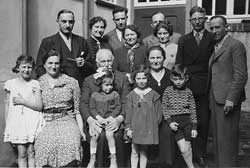 |
The birthday family get-together of Samuel Heuman at his home in Hellenthal, Germany, in the spring of 1938. |
There is a perfectly maintained and beautifully groomed Jewish cemetery, tended by the local community and the German government. So, we visit: Cecilia Heuman, the grandmother for whom sister Doris is named; Joseph Heuman, the great-grandfather, whose gravestone is growing into the tree where it rests; the cousins and neighbors — the Kaufmans, the Haases, the Rotschilds….
Grandfather Samuel Heuman, who lived in Hellenthal in our time, does not have a gravestone. He was murdered in the Holocaust, and his burial place is unknown.
In 1973, on our first visit to Hellenthal, we had some difficulty locating our grandfather’s house, since the streets had been renamed, so we went to the Rathaus for help. The clerk who assisted us was about the same age as Egon, which meant that in 1938 he might have been — at least figuratively — one of the young boys marching as Hitler Jugend by the square. He went into an anteroom, and we saw him leafing through some files, examining records, and making a phone call. When he came back to us he asked, “Was your grandfather German?” Answer, “Yes, of course, for several generations.” Our grandmother and great-grandfather are both buried in the cemetery here, and the names of two of his sons who died for their Vaterland in the First World War are inscribed on a memorial on a hill above town. And then he asked, very sheepishly, “Was he, by any chance, Jewish?” Answer: “Yes, he was.” Clerk: “But you said he was German!”
It was as though someone had slapped us in the face. We were so shocked, stunned, and speechless that we turned on our heels and left. It was incredible to us that in 1973 we were still dealing with the old-guard mentality and the vestiges of the anti-Semitism that had been poured into the kids of that generation. As Americans, we found it impossible to understand the distinction between being German and Jewish, and why you couldn’t be both. Certainly, most German Jews never drew that distinction for themselves.
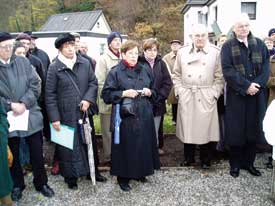 |
Joan Fromm, Sharon Goldstein, and Egon Fromm standing with the citizens of Hellenthal at the Nov. 9 dedication of the Kristallnacht memorial. |
On this trip, quite by chance, we met Hans Peter Bluemel and his wife, Hannelore, a couple a little younger than we are, who had spent most of their lives in Hellenthal and who knew something about the Heuman family. The Bluemels are country folk, bright and well read, who have over the years become good friends. Hans Peter is a history buff and has sent us several books and articles about the Jews of the Hellenthal region, all with photos and information about the Heuman family. Also, since Hellenthal is technically in the Euskirchen region, there are data about the Fromm family. The Bluemels have invited us into their home, we have met each other’s children and grandchildren, and we have congratulated each other’s milestones.
So the years have gone by, and we have seen and felt changes on each trip. Now there is a memorial at the site of the synagogue in Euskirchen and the Hellenthal cemetery, too, has a plaque of remembrance. Townspeople don’t seem so reluctant to speak to us anymore. When they recognize the name “Heuman,” they may nod knowingly. When we stand in the “synagogue” in Euskirchen, we no longer see someone peering at us through a window behind a curtain. In fact, on previous visits we found candles placed around the memorial.
On one trip, in 2000, our daughter Sharon accompanied us. It was special for us because we were able to show her directly the roots and the history of her family, who we are, where we came from, and why. She stood at the grave of her great-grandfather, and came face to face with the fact that her family — generations of people who had planted their seeds here, raised families, contributed their minds, work, and in some cases their lives to this land that they loved and to which they considered themselves an integral part — had been driven from their homes only because they were Jews.
What began as a summer roots trip became a journey on a road that we have traveled many times. This April we returned to our towns, this time in addition to Sharon, with our grandsons Jason, 19, Adam, 16, and Matthew, 13. They had been assigned beforehand (by Grandpa Egon) to look up the towns on the Internet, to trace our route, and answer some questions about why Egon’s family moved to the United States.
We had a wonderful time. The kids visited Grandpa’s school in Euskirchen with him, and took pictures with him under the clock where he learned to tell time. They got to eat (and loved) the Rheinlandische sauerbraten and kartoffelkloessen. They stood at the gravestone of their great-great-great grandfather, buried on a plot of ground in Hellenthal where he had lived as a German citizen all his life. All the others we have mentioned — aunts, uncles, cousins — they too were gone from Hellenthal and Euskirchen, in 1938, ‘39, and ‘40. Many of them were able to escape to the United States, Mexico, Argentina, and New Zealand.
Margot Heuman, Egon’s first cousin, lost all her family — her mother, father (Carola’s brother Karl), and sister — in Auschwitz. By some miracle, after Terezin, Auschwitz, and other horrors, she was liberated from Bergen-Belsen and sought haven in Sweden for several years, before coming to America. She now lives in New York — Riverdale — a real “city girl,” and has recently celebrated her 80th birthday! Though emotionally scarred and at times not able to function for months, she is a skier, a mountain climber, a Big Apple tour guide and an adoring grandmother. She travels frequently through Germany, where she visits people she has met through her various activities. She has also returned to Hellenthal, where she lived as a child.
Through Margot, we learned of a group of non-Jews in Hellenthal (there are no more Jews there) who, two years ago, formed an organized club called JudiT.H — Juden im Thal(valley).Hellenthal. Their purpose was to memorialize and maintain the history of the Jews of the region, who were about 10 percent of the population before 1933. When we found out about the group we told Bernd and Jutta Dreesman, two of the group’s leaders, about our upcoming visit, and we arranged to meet with them. They were as eager to meet with us as we were to meet with them. We had some questions, including: What motivated them? Who were the members of JudiT.H?
Our questions were answered when we sat around a big table, all of us, including our grandchildren. This group of around two dozen people is made up of clergymen, former teachers, and other interested people. We were astounded by the enormous amount of information they had collected about the Jews of Hellenthal and, of particular interest to us, of the Heuman family: where they lived, the businesses they owned and operated, personal data, and what became of most of them after leaving Hellenthal. The group had also decided that with the approach of the 70th anniversary of Kristallnacht, they wanted to commemorate it in a special way, by erecting a monument at the site of where the synagogue stood before it was burned down on Nov. 9, 1938. This was to honor the Jewish citizenry, many of whom had played important and visible roles in the cultural and professional affairs of the community.
So, when this group of non-Jews told us of their plans and showed us a model of the monument, we were overcome with emotion, and there was no way that we would not be a part of it. “We will be here with you for the dedication!” And imagine our boys, not knowing beforehand that they would be witnessing history. Jason, our eldest grandson, was especially moved. He had been a recent participant in the March of the Living, and as he put it, it really “messed up” his head having spent five days trekking from one concentration camp to another. He had no idea then that he would ever bear witness to a group of Germans wanting to remember and to commemorate the Jews of their little town.
On Thursday, Nov. 6, we went back to Germany with Sharon. Though we had been there five times before, we knew that this time would be something very special and very different. We rested on Friday in Cologne, where we always “headquarter,” since all of the towns we visit are a short hour drive from there. We strolled the pedestrian mall, drank the local Koelsch beer, and awaited what would be our three-day whirlwind.
We spent all day Saturday with Manuel von Zelisch, a 29-year-old bright, exuberant, and outgoing doctoral candidate at the university in Bonn. We had been referred to each other by one of the members of JudiT.H and arranged to meet on this trip. We had never been to Bonn before, and he showed us the important sites in this pretty little city on the Rhine, before settling into a quiet private room in a museum, where we spent hours exchanging anecdotes and putting names on the faces in photos we had given him, as well as hearing tidbits he had uncovered about certain family members.
Manuel’s home is in Euskirchen, and he has chosen as his thesis subject the story of Jewish businesses there. He has discovered that Jewish businessmen had played a significant role in the city’s history and social and cultural life. This led him to our parents’ store. He has uncovered information that astounded us, information we never knew and that our parents never spoke about. There was a letter of protest that Walter wrote to the local authorities dealing with a harassing situation that involved the store. The inspectors had alleged that the stair railing leading to the second floor was inches too low, or too high, and therefore not within code (though it had been used for years and long before they occupied the building), and that the store would have to close. There was another letter from Walter requesting reconsideration on a determination that had been made prohibiting a Jewish war veterans group from meeting in a public area. Request denied! It was a fascinating afternoon. Manuel was as excited to spend time with us as we were to be with him.
Sunday, Nov. 9, was the day for which we returned to Germany. At 4 p.m., we gathered in Hellenthal, with more than 100 townspeople, to unveil the JudiT.H monument. A member of the group read the names of those neighbors who had been taken by the Nazis, saying, “We remember those who are not with us….”
Egon and Sharon stood before the group, with tear-filled eyes, and recited the Sh’ma. What would Carola and Walter have thought? Could they have possibly imagined this? Would they have come and stood there with us?
Margot unveiled the monument, two simple upright railroad tracks with a plexiglass insert, upon which was inscribed a poem by Nelly Sachs, a noted survivor. We wondered what Margot was thinking. Could she ever have imagined such a scene?
It was simple, surreal, startling, sad, and solemn. Our hearts were filled with emotion as the townspeople dedicated the monument to their former neighbors at the site of the destroyed synagogue. It was an amazing event to be a part of, as we pondered what had occurred 70 years before.
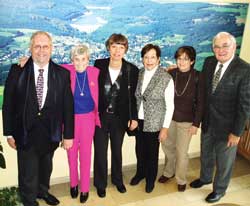 |
From left, Bernd Dreesman, Margot Heuman, Jutta Dreesman, Joan Fromm, Sharon Goldstein, and Egon Fromm stand in front of a mural of Hellenthal. The Dreesmans are leaders of the Judit.H group, the primary sponsor of a monument at the site of the synagogue destroyed on Kristallnacht. |
As if this weren’t “Dayenu,” on Monday we were taken to view an exhibit at a local bank. The JudiT.H group had spent over a year preparing and mounting for display a history of the Hellenthal Jewish population, together with pictures and other memorabilia and a map locating their homes and businesses. One entire board had been mounted of the family Heuman: Grandpa Samuel Heuman’s birthday party surrounded by family; Carola’s and Walter’s wedding with the whole family in attendance; biographies of Margot, her parents, and sister; as well as a recent photo that we had supplied them of us — Egon, Joan, Sharon, Jason, Adam, and Matthew — taken on our April visit to Hellenthal.
The mayor and other dignitaries invited us to a special reception at the Rathaus, where he thanked us for coming back and helping commemorate this event. The mayor, Herr Ernst, a man about 50, asked Joan if she was “comfortable” coming back for this event. She replied, “You’ve all been wonderful; the project, the monument, and the dedication have been beyond anything we could have imagined. It’s been somewhat bittersweet, but when we think back to 1973 over our own 35 years –— having almost been turned away, we have now come full circle, to have witnessed the people of Hellenthal greeting us this way.”
The mayor responded, “We were uncomfortable. In anticipation of your visit, we didn’t know how it would be for all of you after we murdered your parents!”
And so, the three of us, Egon, Joan, and Sharon quietly recited a Shehechianu — for bringing us to this season.
Egon and Joan Fromm live in Franklin Lakes
